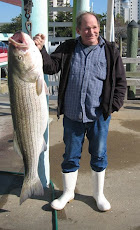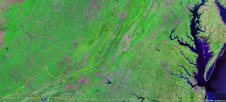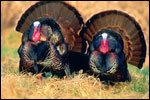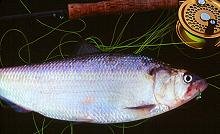Associated Press Writer
RICHMOND, Va. (AP) - Next time you slice up your favorite saltwater fish, consider donating its carcass to science.
The Virginia Marine Resources Commission soon will begin collecting carcasses of several elusive species _ cobia, spadefish, sheepshead, red and black drum, tilefish and grouper _ from recreational fishermen to study the health of the fish populations.
Since 1998, the commission has collected length, weight, sex and age information from more than a dozen species in the Chesapeake Bay. The majority of the samples come from the commercial fishing industry, but some of the species aren't popular commercial catches, so the commission is turning to recreational fishermen to fill the gaps.
"Instead of going out and catching live ones ourselves, we can get much of the data that we need from the remnants of what's already caught," VMRC spokesman John Bull said.
Scientists must remove a fish's otolith, an ear bone that contains growth rings similar to rings in the trunks of trees, to determine its age. Hundreds of samples are needed each year for researchers to get an accurate reflection of the population.
"Why go and kill new fish to do the studies when we can learn the stuff from the dead fish?" Bull said. "That leaves more fish out there for other people to catch."
Bull called the project a "normal, routine, health-of-the-species population assessment" and said scientists have no reason to believe any of the targeted species are in serious danger.
Researchers are interested in how long the fish are living, how big they're growing and other details such as the ratio of females to males to determine what that might mean for the viability of the species.
The project targets fish that are most difficult to catch. Species such as flounder and striped bass are prevalent in the Chesapeake Bay, but the targeted fish either don't flock to the bay in large numbers or don't bite as well, Bull said.
Last year, 26,000 cobia were recorded caught by recreational fishermen, and all but about 8,000 were released, Bull said. In contrast, recreational fishermen caught more than 67,000 striped bass during a four-week season last year in Maryland alone.
A project set up last year to collect sheepshead carcasses produced only 174 donations, said Hank Liao, a scientist at Old Dominion University's Center for Quantitative Fisheries Ecology. VMRC funds the center's Growth and Age Lab where last year Liao and another full-time scientist examined about 6,000 fish in 2006.
Liao said anywhere from 200 to 1,000 fish carcasses are needed to get a proper scientific sample, depending on the species. Some like striped bass live longer, so more samples are needed to get an accurate reflection of the population. Others like spotted seatrout have very short lifespans and only about 250 are required for study.
Cobia remain one of the most elusive. Last year, scientists had only 30 samples to study, Liao said.
"Each year we have to put a specific effort to go to a cobia tournament to collect fish from recreational fishermen," Liao said. "We never get enough."
But organizers of the Marine Sportfish Collection Project are hoping anglers will come to them.
Recreational fishermen will be able to drop off carcasses _ head and tail intact _ in freezers located at several bait shops spread out across the Chesapeake Bay area. They will receive a T-shirt in return.
Bull only hopes anglers will package the remains neatly.
"Hopefully they're not all just dumping their fish skeletons in a freezer and walking away," he said.
The project will continue indefinitely.
If you have fish to donate, you can take them to to the following bait and tackle shops: Wallace's Bait and Tackle in Hampton; Long Bay Pointe Marina in Virginia Beach; and Chris' Bait and Tackle in Capeville.
(Copyright 2007 The Associated Press. All rights reserved. This material may not be published, broadcast, rewritten or redistributed.)
By DENA POTTER
Associated Press Writer
RICHMOND, Va. (AP) - Next time you slice up your favorite saltwater fish, consider donating its carcass to science.
The Virginia Marine Resources Commission soon will begin collecting carcasses of several elusive species _ cobia, spadefish, sheepshead, red and black drum, tilefish and grouper _ from recreational fishermen to study the health of the fish populations.
Since 1998, the commission has collected length, weight, sex and age information from more than a dozen species in the Chesapeake Bay. The majority of the samples come from the commercial fishing industry, but some of the species aren't popular commercial catches, so the commission is turning to recreational fishermen to fill the gaps.
"Instead of going out and catching live ones ourselves, we can get much of the data that we need from the remnants of what's already caught," VMRC spokesman John Bull said.
Scientists must remove a fish's otolith, an ear bone that contains growth rings similar to rings in the trunks of trees, to determine its age. Hundreds of samples are needed each year for researchers to get an accurate reflection of the population.
"Why go and kill new fish to do the studies when we can learn the stuff from the dead fish?" Bull said. "That leaves more fish out there for other people to catch."
Bull called the project a "normal, routine, health-of-the-species population assessment" and said scientists have no reason to believe any of the targeted species are in serious danger.
Researchers are interested in how long the fish are living, how big they're growing and other details such as the ratio of females to males to determine what that might mean for the viability of the species.
The project targets fish that are most difficult to catch. Species such as flounder and striped bass are prevalent in the Chesapeake Bay, but the targeted fish either don't flock to the bay in large numbers or don't bite as well, Bull said.
Last year, 26,000 cobia were recorded caught by recreational fishermen, and all but about 8,000 were released, Bull said. In contrast, recreational fishermen caught more than 67,000 striped bass during a four-week season last year in Maryland alone.
A project set up last year to collect sheepshead carcasses produced only 174 donations, said Hank Liao, a scientist at Old Dominion University's Center for Quantitative Fisheries Ecology. VMRC funds the center's Growth and Age Lab where last year Liao and another full-time scientist examined about 6,000 fish in 2006.
Liao said anywhere from 200 to 1,000 fish carcasses are needed to get a proper scientific sample, depending on the species. Some like striped bass live longer, so more samples are needed to get an accurate reflection of the population. Others like spotted seatrout have very short lifespans and only about 250 are required for study.
Cobia remain one of the most elusive. Last year, scientists had only 30 samples to study, Liao said. "Each year we have to put a specific effort to go to a cobia tournament to collect fish from recreational fishermen," Liao said. "We never get enough." But organizers of the Marine Sportfish Collection Project are hoping anglers will come to them. Recreational fishermen will be able to drop off carcasses _ head and tail intact _ in freezers located at several bait shops spread out across the Chesapeake Bay area. They will receive a T-shirt in return. Bull only hopes anglers will package the remains neatly. "Hopefully they're not all just dumping their fish skeletons in a freezer and walking away," he said. The project will continue indefinitely. If you have fish to donate, you can take them to to the following bait and tackle shops: Wallace's Bait and Tackle in Hampton; Long Bay Pointe Marina in Virginia Beach; and Chris' Bait and Tackle in Capeville.


















No comments:
Post a Comment